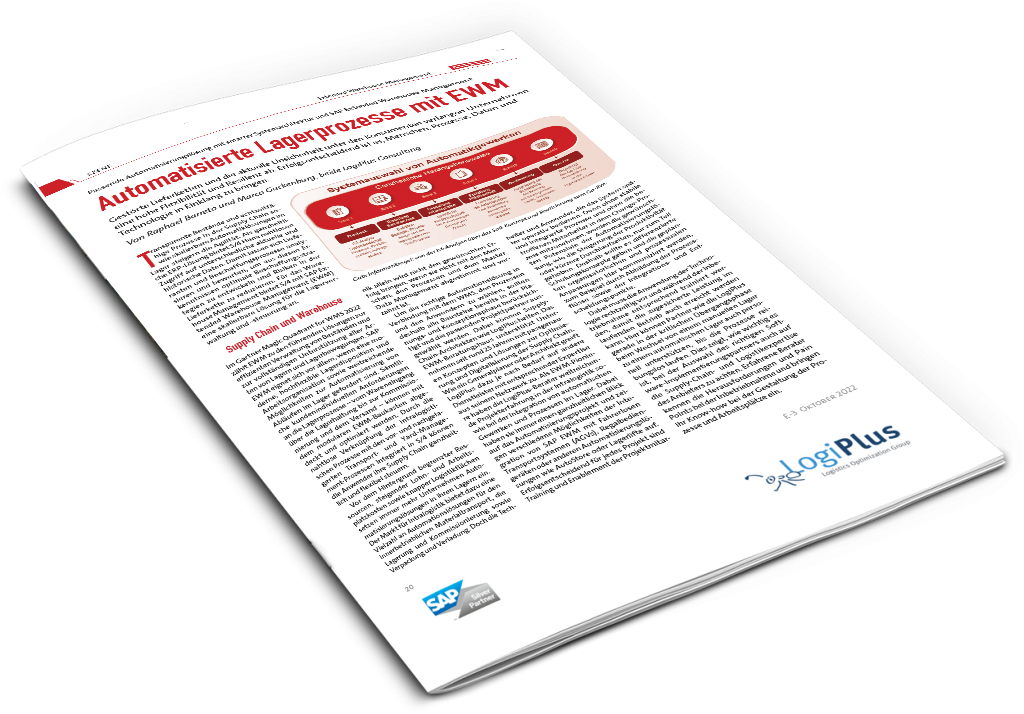Any questions?
Learn more about how our experts can help you digitise and optimise your supply chain in an ever-changing environment.
or call us: +49 621 669 439 0



Disrupted supply chains and the current uncertainty among consumers require companies to be highly flexible and resilient. The key to success is to align people, processes, data and technology.
Transparent inventories and real-time capable processes in the supply chain as well as scalable automated solutions in the warehouse increase the agility. As a holistic ERP solution, SAP S/4HANA offers seamless access to various current and historical data. For the management and control of warehouses, SAP S/4HANA offers a scalable solution – SAP Extended Warehouse Management (EWM).
SAP EWM is one of the leading solutions for the efficient management of inventories and for the complete support of all types of warehouses and warehouse movements – especially when modern, highly flexible warehouse scheduling and work organisation as well as far-reaching possibilities for the automation of processes in the warehouse are required. All customer-specific requirements for warehouse processes – from goods receipt and warehousing to picking and shipping – can be covered and optimised with the modular EWM system. The seamless connection of intralogistics processes with upstream and downstream transport and yard management processes integrated in SAP S/4HANA enables users to manage their supply chain holistically and flexibly.
Against a backdrop of limited resources, rising labor and workplace costs, and limited logistics space, more and more companies are implementing automation solutions in their warehouses. Growing challenges in day-to-day business with volatile incoming orders and at the same time high customer expectations in terms of delivery capability require flexible and easily scalable systems, especially in terms of performance and capacity. There are numerous automation solutions for internal material transport, storage and order picking as well as packing and shipping.
As SAP EWM pioneers, we at LogiPlus have extensive project experience in intralogistics and in the integration of automated trades and processes in the warehouse. In doing so, we always take a holistic view of the automation project and show various options for integrating SAP EWM with automated guided vehicles (AGVs), stacker cranes or other automation solutions such as AutoStore or warehouse lifts.
Which automation solution is ultimately the right one always depends on the individual requirements of the company, its products, the processes required and the space available, as well as other factors. In order to exploit the full potential of an automation solution, all the pieces of the puzzle should be included in the consideration at an early stage in the sense of a holistic supply chain architecture. The solution must therefore also take into account the processes, people and workplaces as well as the existing IT infrastructure and master data. In any case, with SAP EWM, users have a future-proof WMS that can be expanded at any time, even for complex automated processes.
The software implementation partner should have appropriate supply chain and logistics experience to integrate the automated trades as efficiently as possible. Smart system architectures and standard interfaces save licensing and maintenance costs here.
Let us now take AutoStore as an example. Many companies that deal with AutoStore are using SAP EWM. When selecting the appropriate warehouse automation solution, it is equally important to examine not only the physical criteria but also the software-side integration options of the system and its technical interfaces and coupling at an early stage in the system and vendor selection process.
AutoStore offers, for example, various standard interfaces (APIs) for direct connection of the system with the WMS. In addition, the AutoStore Live Simulator can be used to test the processes around the AutoStore system before the hardware is installed. Other intralogistics providers provide a Warehouse Control System (WCS) as middleware to enable self-contained IT integration.
With the task and bin interface, on the other hand, AutoStore provides flexible integration interfaces to meet many company-specific challenges. In contrast to predefined solutions, all parameters can be freely defined via a WCS. This means that the processes can be adapted to the requirements and wishes of the customer.




You are currently viewing a placeholder content from HubSpot. To access the actual content, click the button below. Please note that doing so will share data with third-party providers.
More InformationLearn more about how our experts can help you digitise and optimise your supply chain in an ever-changing environment.
or call us: +49 621 669 439 0

You are currently viewing a placeholder content from HubSpot. To access the actual content, click the button below. Please note that doing so will share data with third-party providers.
More Information